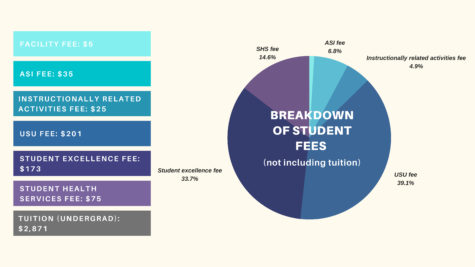Long Beach State will not be waiving any campus-related fees included in tuition for the upcoming fall 2020 semester, according to several CSULB officials.
Many of the fees not being waived include the Associate Students, Inc. fee, set for campus events and activities and the University Student Union fee, which goes toward funding for on-campus food establishments, banks, salon and other on-campus resources.
Aside from the ASI and USU fees, CSULB’s tuition includes a facility fee, a student excellence fee, student health services fee and instructionally related activities fee, which are all student resources that are mainly on campus.
The university suffered a substantial budget cut of $22 million in July due to the effects of the coronavirus pandemic, but campus officials will not be looking to make any changes to the fees.

“At this time, there is no type of adjustment planned as instruction is being offered and academic credit is being earned,” said Jeff Cook, associate vice president of strategic communications for CSULB.
Cook said the pandemic has caused a financial strain on the university, and, while some of the campus-provided programs have been either shut down or transferred to remote delivery, CSULB will still be charging the fees to keep programs running until campus reopens.
“Campus-based fees, such as the student excellence fee and health fee here at CSULB, provide support to programs that students continue to benefit from,” Cook said. “There are ongoing costs related to facility upkeep and staff compensation for programs that continue to run remotely.”
Roughly 77% of the university’s budget goes toward maintaining faculty and staff, with the remaining 23% going toward campus energy cost, maintenance, insurance and renovations, according to President Jane Close Conoley.

However, some students have expressed concerns over the university’s decision to maintain the fee rates.
“I don’t think the fees should remain the same as they were,” said Michaela Chakos, third-year sociology major. “We are getting a compromised education when it is all online. I’m not saying it should be free, but our tuition fees should be significantly reduced.”
Alyssa Neal, fourth-year psychology major, started a change.org petition in May calling for the university to reduce tuition.
“Considering how many of the resources paid for by tuition will be unavailable to students, I stand by my initial belief that CSULB should lower the cost of tuition,” Neal said. “I do not think that the university is being considerate of the many hardworking students like myself enrolled in the university. While these times are unprecedented and we could not have prepared for such a wild year, the school can more than afford to give us a break financially, especially considering we will be paying for things we cannot use.”
Since the posting, the petition has gained almost 3,000 more signees, bringing the total to over 8,000 signatures.
Fees such as those associated with ASI will also remain the same, according to Senior Communications Manager James Ahumada.
Ahumada said the ASI fees are categorized by the California State University Chancellor’s Office as a Category II fee, which are considered mandatory fees required for enrollment at all CSUs per Executive Order 1102.
“This means for us that these fees are not sanctioned for refunds,” Ahumada said. “They primarily finance debt service on facilities, similar to a mortgage, facility maintenance, student employment, permanent staff salaries and benefits, and other fixed costs that support the student services that ASI provides.”
Student fees are also being used to pay off various construction projects, including renovations of the USU in 1994 and the Student Recreation and Wellness Center, which was approved in 2007 with a 74.7% to 25.2% student vote.
Conoley said that the students’ approval in 2007 has allowed for continual support for the buildings and programs on campus.
“Although it is natural for students to see them as ‘usage’ fees, they are actually paying for the mortgages on buildings and the staff who continue to serve the students,” Conoley said.
Main Illustration by Vic Fitzsimons / Daily Forty-Niner.





Pingback: Chancellor select Castro announces plans for time as CSU leader - Daily Forty-Niner